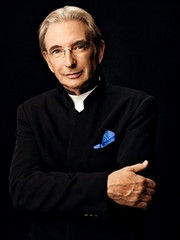|
Back
Aaron Copland New York
Isaac Stern Auditorium, Carnegie Hall
04/13/2016 - & March 30, 31, April 1, 2, 8 (San Francisco), 15 (Newark), 2016
Aaron Copland: Orchestral Variations – Inscape – Piano Concerto
Robert Schumann: Symphony No. 2 in C Major, Opus 61
Inon Barnatan (Piano)
San Francisco Symphony, Michael Tilson Thomas (Music Director and Conductor) 
M. Tilson Thomas (© Art Streiber)
Those expecting an evening of Billy the Kid or Appalachian Spring during the all-Copland first half of the San Francisco Orchestra concert last night might have been disappointed. Little known to general subscriber audiences, the Laureate of American Composers had enjoyed “another life” before and after his Martha Graham period. And Michael Tilson Thomas was ready to give this “unknown Copland” a daring chance.
True, Copland’s well-known Piano Variations are vaguely atonal, his early Organ Symphony studiously jazzy. But the Orchestral Variations and Inscape and the Piano Concerto are certainly unknown in the concert hall. Mr. Thomas, though, who grew up amongst the greatest American and refugee European composers, and who has a visceral longtime relationship with the San Francisco Orchestra, made all three works live, as vibrantly as possible.
The opening Orchestral Variations was new to this listener, but in a few seconds, the sounds of the Piano Variations came rushing into the memory, for these were, in fact an extra “variation” on that austere work. And frankly more welcome. The solo work is masterly, clever, contrapuntally astute. The Orchestral Variations had the luxury of Copland’s orchestration. There ain’t no drums and trumpets in the Piano Variations. The orchestral variations started with Copland’s trademark percussion and brass, and rarely let it down.
Yes, these 20 variations were supposed to be trenchant mutants of a four-note cellular theme. But in its birth-year of 1957, you couldn’t quite take the Graham out of the composer. In its short time sequence, we had Mexican rhythms, joyful string playing and yes, all those brass and drum consorts piling up for the final grand ending.
And those in the audience discomfited by the alien titles in the program, recognized the Copland signatures like old friends, even if the composer had encrypted that signature with more scholarly codes.
That couldn’t quite be said for Inscape which was not quite a 12-tone work. (Since Copland’s teacher, Nadia Boulanger, hated that style, Copland gave only an eleven-tone theme. And since Leonard Bernstein didn’t like the Schoenberg school at all, he apparently gave a half-hearted premiere of the piece in 1967.)
Like its title, taken from Gerard Manley Hopkins’ neologism, Inscape did need some rule books to understand to the max. Unlike the Variations, the music had too many techniques showing. Yes, Mr. Thomas conducted the San Francisco Orchestra with a maximum of transparency. And Mr. Copland, nearing the end of his most creative period, manipulated these techniques with ease. Nonetheless, I could hear those manipulations. Nothing was heavily or out of character. Had this been Roger Sessions, one would have accepted the complexities with equanimity. But Copland, out of character, is not really Copland. One listened with interest but without hearing that electricity, that volition which he had even in the Orchestral Variations.

A. Copland (© Library of Congress)
The final work was the reverse of the first two. This was the (supposedly) jazzy Piano Concerto of 1926, and its compositional value was less than its performer. Inon Barnatan is the young New York Philharmonic artist-in-association, but yesterday evening gave him a chance to shine with the orchestra on the other side of the continent.
As for the music itself, one might compare it to Gershwin’s Rhapsody, written two years before. Gershwin was born for jazz, but that piece was hardly his most inspired. Copland was not born for jazz, but the Concerto had the same elements of a maudlin beginning, a maudlin recapitulation and a central section for the pianist–as well as the percussion and brass–to shine.
Mr. Barnatan made the most of it. His body, his feet pumping the pedals, his obvious relationship with this flashy show. Yes, this was more authentic “jazz” then the European interlopers like Milhaud and Stravinsky. Yet at the same time, this was symphonic, dignified jazz. Pleasant, infectious enough–but never ever the danger of real jazz. It was more Joplin-style ragtime. Though this didn’t lessen the effect.
Two notes. Conductor Walter Damrosch hated the music, and said that the 26-year-old composer would be fated to be a murderer. On the other hand, one would love to have heard that great Russian conductor Serge Koussevitsky conduct the first performance. He was open for anything at all, yet one feels he might not quite have caught the syncopation.
The second half was simply a splendid reading of Robert Schumann’s glorious Second. No, the San Francisco Orchestra lacks the unearthly beautiful strings of the Philadelphia or that European-sounding ensemble of the NY Phil. But Mr. Thomas leaped and bounded and made the entire work noble, majestic, a great work of art. The Adagio was so expressive, the ending was a marvel of martial art ending with victory. Despite his two-decade official relationship with the orchestra, he took no shortcuts. He led them as if it was his first concert with them, giving everything and expecting everything bad in return.
This did call for an encore, and Mr. Tilson Thomas’s reading of Solveig’s Song from Grieg’s Peer Gynt did show the strings with the sensual luxuriousness that the music deserved.
Harry Rolnick
|